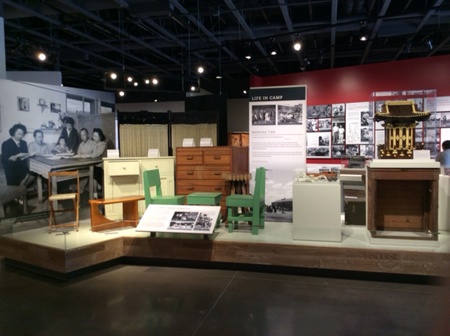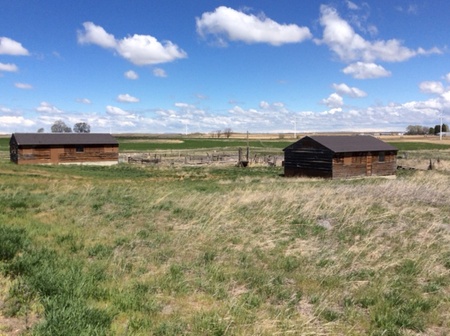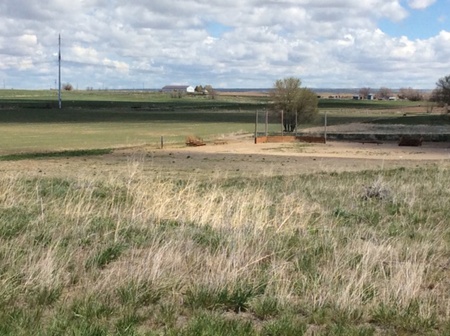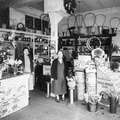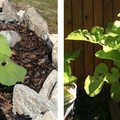TOPAZ MUSEUM-DELTA, UTAH
After Moab, we drove straight west to Delta where the Topaz Museum is located, although to our disappointment the museum appeared to be closed. We stopped next door at the Delta Historic Museum where two ladies assisted us. Apparently, a volunteer there got her schedule mixed up. Again, luck was on our side and the lady opened the door to the Topaz Museum.
I didn’t expect Topaz Museum to be so complete, with wonderful displays of paintings by various artists in the camp. Topaz officially opened on September 11, 1942 and over the duration of the war, over 11,000 were processed through but over 8000 stayed. Topaz consisted of over 19,000 acres of farmland with 640 acres set aside for the town. In some ways, the camp administration was more relaxed compared to other WRA camps. If a Nikkei wanted to move eastward or to attend college, they were given permission to do so. Some chose Chicago to attend university. Most of the internees who were incarcerated at Topaz came from the San Francisco Bay Area. Topaz closed on October 31, 1945. Trick or treat?
The museum officially opened in 2015, but the former Topaz camp site was designated a National Historic Landmark by the National Park Service in 2007. It is a fantastic museum for a town of its size. The staff and volunteers were so engaging and helpful. Tony bought a beautiful painting done by Stephanie Skeem on a piece of dried wooden board.
MINIDOKA, IDAHO
Just twenty minutes from Twin Falls, Idaho you enter Jerome County. On Hunt Road, you will find the Minidoka National Historic Site, which is managed by the National Park System. Although the Minidoka Historic Site does not offer visitor services on site, a display at Minidoka can be seen at the nearby Hagerman Fossil Beds National Monument. Minidoka, which was also known as Hunt Camp, encompassed 33,000 acres and contained over 600 buildings. Presently, the NPS owns and manages over 3000 acres of the original camp. This includes the original guard and fire stations, a Japanese style rock garden, a root cellar and several warehouses. This center is an ongoing project. Friends of Minidoka have been assisting in the reconstruction of the historic Honor Roll monument, the guard tower (with the help of Boise State University Construction Management Program) and a baseball field. The former Herrmann House (Farm in a Day) is now the Visitor Centre.
When we first arrived at this site, the Honor Roll monument stood out. This structure was built in 1943 to commemorate the Nisei soldiers from Minidoka who served in the U.S. Army during World War II, thus the names of new recruits were added as more men volunteered or were drafted. There is also a memorial plaque for the soldiers who lost their lives. Nearby, you can see the stone foundation and fireplace of the old police station. The North Side Canal runs behind the station and guard tower, which is a fairly long walk to the visitor's centre. Along the way, there are interpretive panels that help visitors imagine the former administration buildings. To my surprise, I spotted a photo of Dr. Robert Hajime Shiomi tending to a young boy in camp. Dr. Shiomi emigrated from Sashima, Seto Nai Kai or the Inland Sea of Japan and was the only Asian student at Failing Elementary School in Portland, Oregon where he attended. He graduated from the University of Oregon in 1930. His mother and my grandfather are siblings.
When we arrived, again, the center looked like it was closed. However, I noticed a car parked near the fire station. The lady in the office heard our voices so she came out to greet us. The old Herrmann House is very small but I managed to buy three Minidoka pennants for half price and a fridge magnet. As a result, the lady gave my sister-in-law Dianne, a plastic coated office map of Minidoka to give to me.
Most of the exhibits are outdoors. The Friends of Minidoka had recently completed restoration of the baseball field and are still looking for stories from former internees. At the Minidoka Internment site, Japanese Americans could get a day pass to drive into Twin Falls to watch a movie or to shop.
Sugar beets were cultivated and harvested to help with the war effort. When a five-mile barbed wire fence was built in front of the camp, some people were upset because they now had to walk a long distance to get to the farm area. Eventually, someone snipped the wires to create a short-cut to the farm.
Other interesting facts we learned about Minidoka include: In August of 1943, Minidoka firefighters helped subdue a wildfire 60 miles from camp. Such effort helped ease the tension between the local residents and the internees.
Although eight guard towers were built, the towers were not staffed. The barracks were not in neat rows like in other camps due to the unevenness of the ground.
Minidoka was supposed to have been the least controversial of all the camps. It was considered a ‘quiet camp.’ Most inmates were from Washington, Oregon and a few Japanese Americans from Alaska. I wonder if that was the reason for a more harmonious existence under the strain of being imprisoned? Minidoka closed October 28th, 1945.
In Canada, Japanese Canadians also contributed to the wartime sugar beet industry. Many of the B.C. families chose to go to Alberta or Manitoba to work on the sugar beet farms so that their families could stay together. However, they were given a shack to live in, and the work was very strenuous. Once the harvesting ended, they had to improvise and find other means of income. The living conditions were horrendous. If a family had too many young children, the farmers didn’t choose them. The farmers thought that very young children were incapable of working on the farm.
YAKIMA VALLEY NIKKEI FARMERS
Our final stop on our tour was in Yakima, Washington. Prior to Yakima, we stopped in Baker City, Oregon to visit the Oregon Trail Interpretive Center. I could have spent a whole day there!
We visited the Yakima Valley Museum, where we learned that there were several Japanese American built farming communities leasing land on the Yakima Indian Reservation back in the early 1900s. The names of places like Wapato and Toppenish became very familiar to me after I read Tammy Ayers’ articles on the Discover Nikkei website. The special exhibition featured at the Museum was called “Land of Joy & Sorrow– Japanese Pioneers of the Yakima Valley.” Most of the Yakima Valley JAs were first sent to the Portland Assembly Center and then relocated to Heart Mountain, Wyoming. After the war, most people didn’t return, but those who did tried to reclaim their lives and rebuild their community in Wapato. Yakima was another Nikkei historical gem found on our journey through the western states.
HOMEWARD BOUND
When I returned home to Vancouver, I was so overjoyed that one of the items on my bucket list was completed. I think this trip produced a learning euphoria for me. Just to physically experience the desert landscape surrounded by very high glacier mountains in the background like in Manzanar allowed me to imagine what life was like back in 1942. B.C. camps had the extreme hot and cold weather surrounded by high mountains. The ‘camps’ in Canada were miniscule compared to Poston, Arizona with over 17,000 peak population and Tule Lake with over 18,000. There were as many Nikkei interned in the Tule Lake camp than all of the ten camps combined in Canada!
There were strikes, riots, violence, separation, tension between the ‘No-No’ and the ‘Yes-Yes’ groups, behind barbed wire fences and guard towers. Yet, on a happier note, there were communities built with schools, sports, arts and music activities. The Nikkei made the best of the situation by working hard, being creative and resourceful. The strong mental strength to ‘gaman’ (persevere) and being resilient helped them overcome the imprisoned life under harsh weather conditions.
When you think that the camp life was arduous, the return ‘home’ was even more challenging. Some were fortunate to have good people in their communities to take care of their farms or businesses. Others had nothing to go back to. Some returned to be housed in temporary shelters at Buddhist and Christian churches, or in hotels owned by JAs. Getting a job was a challenge. The returning Nikkei weren’t exactly welcomed back. How they managed to eke out a living by being frugal to save enough money to buy a house is phenomenal. No wonder ‘mottainai’ is in the Japanese Americans and Canadians cultural DNA.
We, Canadian Nikkei, lost nearly everything and to make matter worse, we weren’t allowed back to the West Coast until 1949. That was the year when Japanese Canadians were given the right to vote and have equal rights like all other Canadians. In 1946, the government gave an ultimatum of “Go East of the Rockies or ‘Repatriate’ to Japan.” They were offered money to go back to Japan but in order to do so, they had to renounce their Canadian citizenship.
The war hysteria and propaganda made Nikkei into ‘villains.’ Was it military security measure or was it ethnic cleansing? It is difficult to imagine that one of the most law-abiding citizens of both countries were considered a threat to their nations.
One Japanese American during the public hearing to the Commission’s report to Congress stated:
“......History cannot be undone; anything we do now must inevitably be an expression of regret and an affirmation of our better values as a nation, not an accounting which balances or erases the acts of war...
“It is well within our power, however, to provide remedies for violations of our own laws and principles.”
This message was displayed at the Yakima Valley Museum. Yes, we cannot undo what has happened. How do we move on with our lives? The National Parks Service and the younger Nikkei are working in partnership to create an educational component in the internment camp interpretive centers to tell the stories to the future generation, with the hopes that future human rights and civil liberties will not be violated. We stand on guard for thee.
© 2018 Chuck Tasaka


